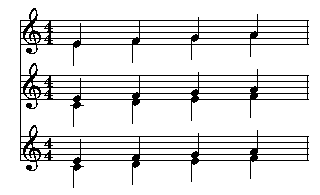There is an alternate input style, in which you enter music a chord at a time, rather than a voice at a time. In this style, the specification before the colon gives one or more patterns that tells how to map notes to staffs and voices.
Suppose you want to print some
music in a style which is common for many traditional hymns:
it is to be printed on two staffs, each staff will always have
exactly two notes, and the rhythm is exactly the same for all voices.
With chord at a time input, you specify, for each note in a chord,
which staff and voice to map that note. Since there are four notes in
each chord, there will be four mappings listed. You want the bottom
two notes to get mapped to staff 2, and the top two notes to staff 1.
This is shown as
// Bass to staff 2 voice 1 // | Tenor to staff 2 voice 1 // | | Alto to staff 1 voice 1 // | | | Soprano to staff 1 voice 1 [ 2 1; 2 1; 1 1; 1 1 ]
Since voice 1 is, as always, the default, this could be written more
compactly as just:
[ 2; 2; 1; 1 ]
// Soprano // Alto // Tenor // Bass [ 1; 1; 2; 2 ]
// Bass to staff 2 voice 2 // | Tenor to staff 2 voice 1 // | | Alto to staff 1 voice 2 // | | | Soprano to staff 1 voice 1 [ 2 2; 2 1; 1 2; 1 1 ]
Now let's put these mappings with music data.
score
staffs=2
vscheme=2f
staff 2
clef=bass
music
[ 2; 2; 1; 1 ] : facf;dgfb;2cgec+;
bar
[ 1 1; 1 2; 2 1; 2 2 ] : fcaf;bfgd;2c+egc;
bar

It is also possible to use rests or spaces for some of the voices.
score key=3& vscheme=2f music [ 1 2; 1 1 ]: rb; eg; ca; gr; bar [ 1 2; 1 1 ]: er; sr; 8sf; se; 4sg; bar

Chord attributes and interchord attributes (like tie, slur, xnote,
len, and alt) can be specified just like
for voice-at-a-time input. Note attributes (like ? and ~) apply to
the note wherever it gets mapped, and items that apply to the chord as
a whole will be applied to all the notes.
[1 2; 1 1] : [cue; xnote; len 6] b-e; [with > ] ce& slur; dg~; c?g;

It is possible to map a note to more than one place by using ranges,
and/or by giving a list of staffs and voices,
separated by ampersands. This may be useful,
for example, if several voices are in unison.
In the next example, the first note in each chord will be mapped to voice
1 of staffs 1 through 3, as well as to voice 2 of staff 1, while the
second note in each chord will be mapped to voice 2 of staffs 2 and 3.
[ 1-3 1 & 1 2; 2-3 2 ] : ec;fd;ge;af;

It is also possible to specify more than one bracketed mapping.
Each must include a mapping for a different number of notes.
So, for example, if some chords in a measure have two notes and
others have three, you can define two maps: one for two notes,
and one for three. The example below demonstrates placing alto
and soprano as two voices on one staff, but sometimes the alto
part splits.
// For chords with two notes, // map the first to staff 1 voice 2 (alto), // and the second to staff 1 voice 1 (soprano). // For chords with three notes, // map the first two notes to staff 1 voice 2 // (first and second alto part), // and the third to staff 1 voice 1 (soprano). [ 1 2; 1 1 ] [ 1 2; 1 2; 1 1 ]: cec+;df;eg;a-fc+;

Since the mapping specifications can get rather complex, and they may be used many times during a song, it is usually best to define macros for them, and possibly even put the macro definitions in an "include" file.
You can use the different input styles in different measures of a single song, and use different mappings in different measures. You can even mix the two input styles within a measure, but a given staff/voice can only appear on one line of input per measure. So, for example, you could choose to input staffs 1 and 2 of a song in chord-at-a-time input style, and staff 3 in voice-at-a-time style.